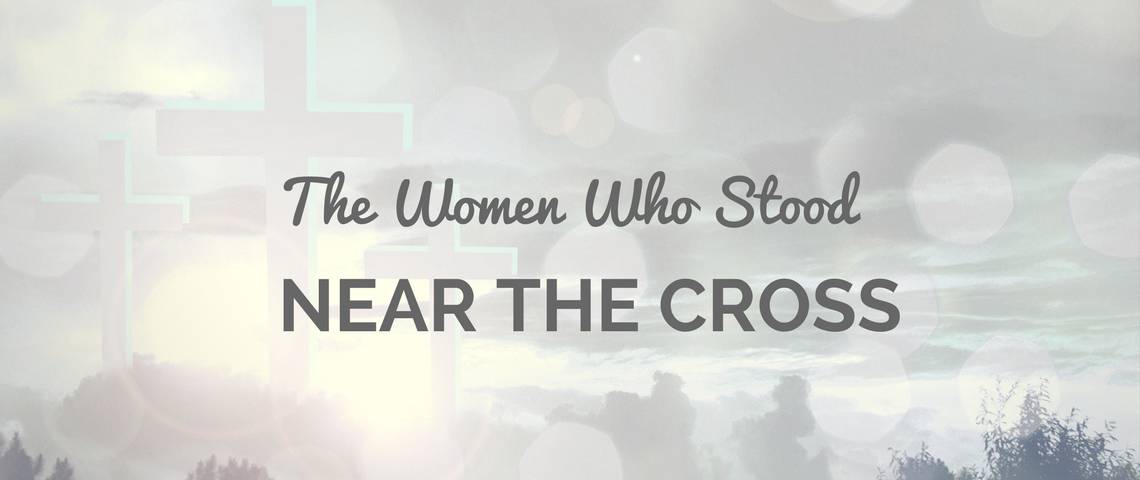“Some women were watching from a distance, including Mary Magdalene and Mary the mother of James and Joses, and Salome. When Jesus was in Galilee, these women had followed and supported him, along with many other women who had come to Jerusalem with him.” (Mark 15:40-41)
We know from all four gospel writers that a number of women were present at the crucifixion and death of Jesus and that some of those women were also at the burial and the empty tomb. Who are these women who stood near the cross, and what can we learn from their example of discipleship?
There Were Many Women
Matthew and Mark note that there were “many women” watching in the crowd that day. All of the gospel writers mention a few women specifically, presumably those who would have been known to their readers.
Matthew names Mary Magdalene, Mary the mother of James and Joses, and the mother of the Sons of Zebedee (27:55-56).
Mark also names Mary Magdalene and Mary the mother of James and Joses, and then adds Salome (15:40-44).
Luke identifies Mary Magdalene, Joanna, and Mary, the mother of James (24:10).
John expands the list to include the mother of Jesus, his mother’s sister, and Mary of Clopas, in addition to Mary Magdalene (19:25).
Some scholars believe there may be some overlap in the lists. But even taking that into account, the fact that 6-8 women are singled out of the “many women” mentioned in the text is telling. For many of us, this radically changes our vision for who was present that final week of Jesus’ life.
The Women Were Disciples
These were women who had followed Jesus from Galilee. We first read about them in Luke 8:1-3, where two distinct groups of followers are mentioned, the Twelve and “certain women”.
“After this, Jesus traveled about from one town and village to another, proclaiming the good news of the kingdom of God. The Twelve were with him, as well as some women who had been cured of evil spirits and diseases: Mary (called Magdalene) from whom seven demons had come out; Joanna the wife of Chuza, the manager of Herod’s household; Susanna; and many others. These women were helping to support them out of their own means.”
It becomes obvious when we read the gospels that these verses are not referring to a one-time event, but describing what is true from this point forward (see Gospel Women: Studies of the Named Women in the Gospels by Richard Bauckham). From this point on, Jesus is preaching and teaching with a wider group than just the Twelve, a group that included women.
These women were not just supporting cast members. When the Twelve are called we read that “they left everything and followed Jesus” (Luke 5:11). This concept of “following” is often used to describe discipleship in the gospels, and we find it also used here in reference to the women (see The Gospel of Mark: A Commentary by Francis J. Moloney).
Just like the men, the women who stood near the cross were “with” Jesus. They had given up everything to follow, including the safety and security of their homes, relationships, and reputations. The women were also providing for the ministry financially.
The Women Follow to the End
We can imagine that when the disciples headed to Jerusalem that fateful week, their expectations were quite different from what they experienced when they got there, regardless of gender. Things escalate quickly once Jesus is arrested, and we see the disciples respond in three ways. Some of them run (including Peter), some watch from a distance, and some stand near the cross.
While the male disciples are conspicuously absent from this point in the story on, Matthew, Mark, and Luke tell us that many of the women are still present. And John places four of them “near the cross” along with “the disciple Jesus loved” (John 19:25). This smaller group is close enough to have a private conversation with Jesus, which reveals that their nearness is not only positional but also relational.
I used to give the male disciples a pass for not having the courage to stand near that day, thinking that the risk might have been greater for them than for the women. But historical accounts tell us that the Romans had no qualms about crucifying women in that era. Many of the details we have about the death, burial, and resurrection are recorded because these women had the courage to stay near the cross. And after that, the courage to stay near the tomb, even when it seemed that all was lost.
Counting the Cost
Holy Week offers us the opportunity to evaluate our own positional closeness to Jesus and to count the cost of discipleship.
- Will we follow in the steps of those who were “with him”?
- Will we honor his inclusive model of discipleship?
- Will we provide sacrificially to proclaim his Good News to others?
- Will we risk reputations, relationships, even our very lives to follow?
- Will we stand near, watch from a distance, or run in the other direction
This post first appeared on the Seedbed blog.





11 responses to “The Women Who Stood Near the Cross”
Thank you so much for this article. It has build my faith more . As a female pastor I face a lot of challenges both from the church and male pastors as well. I hope that one day their eyes will open to the truth.
Bless you, sister! So glad it was helpful!
Thanks, as always, for your insights, Gail. I’d like to add this observation/suggestion: Mary, the mother of James and Joses, was the same person as Mary, the mother of Jesus. Earlier references in the Gospels identify James and Joses among Jesus’ brothers (Mark 6.3, for example). For some reason, the gospel writers other than John chose to identify her indirectly. I can’t imagine being able to watch a crucifixion at all, much less the crucifixion of your own son. Truly an amazing woman of faith — blessed among women, to be sure.
I remember when I first really became aware of the way women were treated in ministry was when I watched Dead Man Walking (made in 1995, rated R). A man is found guilty of the rape and murder of a young couple. He is sentenced to death row. As he nears his execution he asked that a nun who regularly visits the prison to minister him in his final days.
It’s a hard movie to watch because of the nature of the crime, but what struck me the most was how the nun is treated by everyone else. Of course her family and the victims families can’t understand why she would want to help someone like that, but comments along the lines of “why are you here at the prison when you could be running Sunday school?” really irritated me. Everyone seemed to think it was odd or even wrong for her to want to be involved, but they had no problem with a male doing it. Like it was weird for a woman to want to do something that wasn’t pleasant and didn’t involve fun Bible stories and coloring. It’s almost like saying that women can’t handle the harder stuff, only men can.
There isn’t anything wrong with Sunday school or children’s activities, those are extremely important. It’s not demeaning. But acting like that’s all that women should want to do is insulting.
I’ll bet that when the male followers found out about the women at the cross they didn’t question why they were there, or asked them if they would have been more helpful elsewhere.
Anyway, I thought of it when I read this post. Thank you for posting it.
This will be the first Good Friday service I’ve ever preached. I was feeling incredibly nervous, now I feel as though I will be standing tonight among a great cloud of witnesses who have been there since the very first Good Friday.
Thank you for this.
So glad you have this opportunity, Megan! Yes, there will be a host of us cheering you on, both in heaven and on earth! Praying for the Spirit to rest fully on you as you preach!
Thank you.
Gail, thank you for these insightful observations. It is important to note that the only person to whom Jesus overtly acknowledged his identity as the Messiah prior to the Passion Week was the Samaritan woman at the well in Sychar (John 4: 1-42). And this confirmation came to a Samaritan woman of questionable reputation, so the last person we would have expected Jesus to announce this.
Furthermore, Jesus sent 12 men to get food for 13, so that he could do the work of the gospel and offer this insightful woman living water. She received this water, even with a limited understanding initially, went to her town and shared her experience with Jesus (witnessed). The result was amazing and the men of the town became believers from their own experience with Jesus.
I have been an ordained minister for many years and I am pretty sure that is our basic job description. Clearly if Jesus inspired this woman and trusted her to share the gospel with a group of people hated by the organized religion of the day, we should support women serving as senior pastors and every position of the Church.
One other note (that I credit to conversations with Ken Waters). When we focus on this woman’s marital status, we forget her limited options for survival at that time. Also, by focusing solely on her, we take away the focus on us-the family and community (read here-church) who had a responsibility to support her and take her in. Often times the church focuses on the “sins” of the individual to avoid our social justice responsibilities so clearly outlined in many places in scripture (see Amos 5: 11-27.
So, as we celebrate the death and resurrection of our Savior, we can celebrate a Messiah that includes all people and especially those we push to the periphery of society. We will honor Him, when we risk going to the modern “Sychars” of our day and share the Good News of Living Water Salvation. My prayer is that I will be part of that group and not the 12 disciples who had to be sent away to get food for 13 men, so they would not be an impediment to the building of the Kingdom.
While we don’t have a scriptural record to verify this, I think it is very likely that following Peter’s experience at the home of Cornelius, when the Holy Spirit clearly revealed that all people were to be included in gospel message, and they were trying to make sense of all of this, one of the disciples would have remembered those few days in Sychar (see Acts 10 & 11).
In fact, this was a ministry field trip intended by Jesus to begin planting a seed regarding an inclusive Kingdom that was unimaginable for them at that point. When Jesus told them to look up at the fields ripe for harvest, he was referencing the Samaritan men who were walking toward Jesus…all because a “Samaritan woman of questionable reputation” left her water jar at the well, returned to her village and “said to the people. Come, see a man who told me everything I ever did. Could this be the Christ?” (John 4: 28-29 NIV)
Brent Wood
YES! Sometimes people call Mary Magdalene the first woman evangelist, but it was really the Samaritan woman of Sychar, as you so well explained. Always appreciate your insights, Brent!
Gail,
I am also an MK from Japan. I was born and raised there. I found your article interesting. If, as you point out, with your group that Christians should adopt Gloria Steinem and Betty Friedan’s misandric feminism, with a cross stapled on the books what about the disciples? If First Timothy 2 is to be papered over with these same books why did Jesus select only males for his 12 disciples? Why do we think it is a good thing to follow the path of left wing, secular humanists who themselves are hostile to the Kingdom. While obtaining my Political Science degree from Cal State Fullerton I too several “women’s studies” classes I remember distinctly hearing the hostility of the teachers and the writers to the Bible and particularly the writings of the Apostle Paul. Gail, why is making a Biblical case for those who hate the Kingdom and mock all that we believe a good idea? Finding common cause with secular, misandric feminism is not unlike reading the writings of Anton Lavay or Karl Marx and finding the good in them. Why help our enemies? I don’t get the infatuation of Christian women with the writings and teachings of Gloria Steinem and Betty Freidan. If you take a look at their lives and their writings and their world view that are hostile to all aspects of Christianity. What draws you to misandry and feminism?
Hello, James. Where were you in Japan? Did you attend CAJ? We were in Okinawa. I must say that I don’t see how you could possibly come to the assumptions and conclusions you make from the content of the post. The only thing that draws me to equality for women is the Word (Jesus) and the word (interpretation of scripture). As you may or may not know, most Wesleyan-Holiness streams of Christian faith support this view as well as the American Baptist tradition that I was raised in. Feel free to comment on the actual post content and let me know what it is in the post you are objecting to.